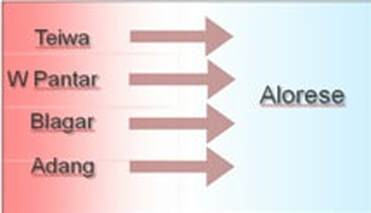Project
Case studies of contact-induced change
|
Exploring the difference between linguistic borrowing and inheritance...
|
Project 3: Transfer of structure: Alorese and its Papuan neighbours
Investigator: Francesca Moro (Postdoc)
When adults adopt a new language – for example when women speaking language L marry into a language community A – they will introduce grammatical structures from language L into A, and pass their variety of A onto their children. If this goes on for several generations, and involves several different languages (L, K, M, N) of equal social status that are used in similar social domains, we hypothesise that A and L, K, M, N will start to share grammatical structures, while their lexicons remain distinct. In this second case study of language contact we study Alorese (Austronesian) in relation to the Papuan languages spoken in its vicinity: Teiwa, Western Pantar and Blagar on Pantar, and Adang on west Alor. We investigate the language of adult speakers who were born in a Papuan speaking environment and learned Alorese as a new language, e.g. when they married an Alorese husband. The synchronic description of their language will involve charting lexical and grammatical influences of Papuan languages on Alorese.
Investigator: Francesca Moro (Postdoc)
When adults adopt a new language – for example when women speaking language L marry into a language community A – they will introduce grammatical structures from language L into A, and pass their variety of A onto their children. If this goes on for several generations, and involves several different languages (L, K, M, N) of equal social status that are used in similar social domains, we hypothesise that A and L, K, M, N will start to share grammatical structures, while their lexicons remain distinct. In this second case study of language contact we study Alorese (Austronesian) in relation to the Papuan languages spoken in its vicinity: Teiwa, Western Pantar and Blagar on Pantar, and Adang on west Alor. We investigate the language of adult speakers who were born in a Papuan speaking environment and learned Alorese as a new language, e.g. when they married an Alorese husband. The synchronic description of their language will involve charting lexical and grammatical influences of Papuan languages on Alorese.
The results will be crucial for the reconstruction of the history of the Alorese. Preliminary studies (Klamer 2011, 2012) suggest that Alorese is closely related to Lamaholot, and that the ancestors of the Alorese arrived on the Pantar coasts during the last millennium. Initial lexical comparisons of 400-item basic word lists also indicate that Teiwa, Western Pantar, Blagar and Adang contributed to the lexicon of the Alorese spoken on Pantar. There is no evidence to date that one of these Papuan languages was more influential than the other, which suggests that the Papuan languages and Alorese have equal status. The limited lexical data also suggested that the languages are spoken in similar domains. However, we expect that a more extensive collection of non-basic words will reveal that languages were used in different social domains – for example, language L may have influenced oral traditions because of a shared historical episode, while language M donated kinship vocabulary because of marriage alliances – and that not all the Papuan languages had equal influence on Alorese.
Comparisons of the morphology and syntax of Lamaholot and Alorese indicate that after the split, Alorese underwent extreme morphological simplification. This is generally taken to be suggestive of a stage when it was learned by non-native adult speakers (Hickey 2007, Trudgill 2010b). However, adult acquisition of a new language is typically accompanied by introducing grammatical structures from heritage language into target language. Interestingly, our pilot studies show no traces of Papuan grammatical influences on Alorese.
Questions addressed include: What caused Alorese to lose all of its morphology while no grammatical convergence occurred? Is this also what happens today when Papuan adults learn Alorese? What is the role of the native Papuan languages of newcomers vis-à-vis the community language Alorese and the transfer of Alorese to the next generation?
References Link
